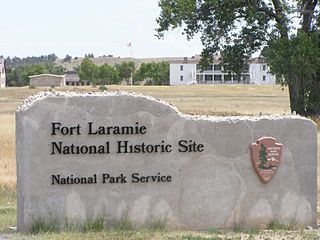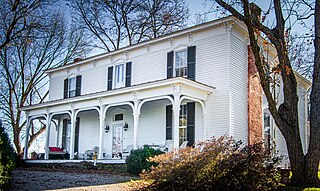
The Presidio of San Francisco is a park and former U.S. Army post on the northern tip of the San Francisco Peninsula in San Francisco, California, and is part of the Golden Gate National Recreation Area.

Fort Laramie was a significant 19th-century trading post, diplomatic site, and military installation located at the confluence of the Laramie and the North Platte Rivers. They joined in the upper Platte River Valley in the eastern part of the present-day U.S. state of Wyoming. The fort was founded as a private trading-post in the 1830s to service the overland fur trade; in 1849, it was purchased by the United States Army. The site was located east of the long climb leading to the best and lowest crossing-point over the Rocky Mountains at South Pass and became a popular stopping-point for migrants on the Oregon Trail. Along with Bent's Fort on the Arkansas River, the trading post and its supporting industries and businesses were the most significant economic hub of commerce in the region.

Westover Plantation is a historic colonial tidewater plantation located on the north bank of the James River in Charles City County, Virginia. Established in c. 1730–1750, it is the homestead of the Byrd family of Virginia. State Route 5, a scenic byway, runs east–west to the north of the plantation, connecting the independent cities of Richmond and Williamsburg.
Augusta Township was one of the seven original townships of Northumberland County, Pennsylvania in the United States. It was formed in 1772 and ceased to exist on April 13, 1846 when it was divided into Upper Augusta and Lower Augusta townships.

Jobbers Canyon Historic District was a large industrial and warehouse area comprising 24 buildings located in downtown Omaha, Nebraska, US. It was roughly bound by Farnam Street on the north, South Eighth Street on the east, Jackson Street on the south, and South Tenth Street on the west. In 1989, all 24 buildings in Jobbers Canyon were demolished, representing the largest National Register historic district loss to date.

Munson Valley Historic District is the headquarters and main support area for Crater Lake National Park in southern Oregon. The National Park Service chose Munson Valley for the park headquarters because of its central location within the park. Because of the unique rustic architecture of the Munson Valley buildings and the surrounding park landscape, the area was listed as a historic district on the National Register of Historic Places (NRHP) in 1988. The district has eighteen contributing buildings, including the Crater Lake Superintendent's Residence which is a U.S. National Historic Landmark and separately listed on the NRHP. The district's NRHP listing was decreased in area in 1997.

The Central United Methodist Church is located in Downtown Detroit, Michigan. It was designated a Michigan State Historic Site in 1977 and listed on the National Register of Historic Places in 1982.

This is a list of the National Register of Historic Places listings in Detroit, Michigan.

Lindsay Applegate was an American pioneer known for his participation in blazing the Applegate Trail, an alternative route of the Oregon Trail. The trail was blazed with his brothers Charles and Jesse in 1846, though Charles was not a member of the party that blazed the section of the Applegate Trail from the Willamette Valley to the Humboldt River. According to an original manuscript written by Lindsay Applegate in 1877, the members of the expedition were: Capt. Levi Scott, John Scott, Henry Boygus, Lindsay Applegate, Jesse Applegate, Benjamin Burch, John Owens, John Jones, Robert Smith, Samuel Goodhue, Moses "Black" Harris, David Goff, Benit Osburn, William Sportsman, and William Parker.

The Jacobus Vanderveer House, also known as Knox House, is a U.S. Federal style house located just north of the community of Pluckemin in Bedminster Township, Somerset County, New Jersey at the junction of US 202 and 206 north of River Road. The house was added to the National Register of Historic Places on September 29, 1995, and noted as an "excellent example of a Dutch–American house". The Vanderveer /Knox House & Museum while owned by Bedminster Township, is operated under the direction of the Friends of the Jacobus Vanderveer House, a 501-C3 non-profit organization. The Jacobus Vanderveer House is situated on part of the 218 acres (0.88 km2) that make up River Road Park. The house was thought to be built somewhere in the mid-1770s by James (Jacobus) Vanderveer, son to Jacobus Vanderveer after the property was willed to him by his father.
Old Town, also known as the Thomas Brown House, is a house in Franklin, Tennessee, United States, at the Old Town Archeological Site that was built by Thomas Brown starting in 1846. It is a two-story frame structure built on an "I-House" plan, an example of vernacular architecture showing Greek Revival influences. The Thomas Brown House is among the best two-story vernacular I-house examples in the county.

The Apheus Truett House is a frame house located at 228 Franklin Road in Franklin, Tennessee, that was listed on the National Register of Historic Places (NRHP) in 1988. Built in 1846, it is a notable example of a two-story vernacular I-house structure in Williamson County. It includes Central passage plan architecture. The NRHP listing is for an area of 5.2 acres (2.1 ha), with one contributing building and two non-contributing structures.

The Thomas L. Critz House, built c.1887, is a historic Italianate style house in Thompsons Station, Tennessee that was listed on the National Register of Historic Places in 1988. It is a two-story frame residence with a Central passage plan. It has a one-story porch with square chamfered columns.

The James Scales House, built c. 1885 in Kirkland, Tennessee, United States, along with the William W. Johnson House, another Williamson County house, are notable as late 19th century central passage plan residences that "display period decoration at eaves and porch." It includes Stick/Eastlake, I-house, and central passage plan architecture.
Idlewild, also known as the Downman House, was a historic home located at Fredericksburg, Virginia. It was built in 1859; a fire in April 2003 destroyed most of the interior and collapsed the roof. It was a 2+1⁄2-story, Gothic Revival-style brick dwelling with an English basement and an irregular "T" shape with a center passage plan. The house was topped by a steep slate gable roof. Also on the property at present are three contributing brick dependencies and a contributing pet cemetery. During the American Civil War, Idlewild became a prominent landmark on 4 May 1863, during battle action related to the Chancellorsville campaign. On that evening Confederate General Robert E. Lee used the house as his headquarters, after being initially occupied that day by Federal troops of the Union Sixth Corps.
The SS Homer was a sidewheel paddle steamer which plied the waters of the Mississippi River and its tributaries. Built in 1859 in Parkersburg, West Virginia, she was 148 feet (45 m) long, 28 feet (8.5 m) wide, and 5 feet (1.5 m) deep. Her first significant service was in 1860, when she was used as a packet steamer on the Red and Ouachita Rivers, under master and co-owner Samuel Applegate. In 1861, after the start of the American Civil War, she was contracted to the government of the Confederate States of America, and was used to transport men and war materiel. She was used to supply the defenders of Port Hudson, Louisiana, in 1864. That year she was captured by the Union Army forces of General Frederick Steele when she was about 30 miles (48 km) below Camden, Arkansas on the Ouachita River. Steele was at the time engaged in a major expedition whose goal was to reach Shreveport, Louisiana, but had stalled due to Confederate resistance and a lack of supplies. Steele had then occupied Camden, and it was during this occupation that the ship was taken, loaded with grain and other supplies. The Union forces piloted her back to Camden.

The David Sumner House is a historic house at 4 Station Road in Hartland, Vermont. Built about 1807, it is a fine local example of Federal period architecture, exhibiting the influence of architect Asher Benjamin. It was built for David Sumner, a major local landowner and operator of sawmills. The house, now the Sumner Mansion Inn, was listed on the National Register of Historic Places in 1989.

The Willis House is a historic residence in Encampment, Wyoming, United States, that is listed on the National Register of Historic Places.

The William Bush House, at 1927 Tunnel Hill Rd. in Elizabethtown, Kentucky, is a historic house built in 1817. It was listed on the National Register of Historic Places in 1988.
The Ditto-Prewitt House, at 306 Elm St. in West Point, Kentucky, is a historic house built in 1826. It was listed on the National Register of Historic Places in 1988.
















